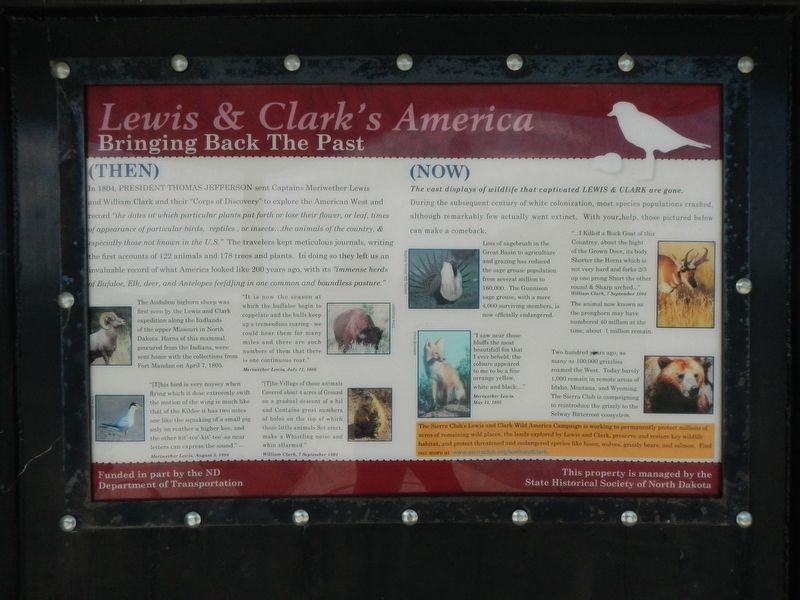Near Williston in Williams County, North Dakota — The American Midwest (Upper Plains)
Lewis & Clark's America
Bringing Back The Past
In 1804, President Thomas Jefferson sent Captains Meriwether Lewis and William Clark and their "Corps of Discovery" to explore the American West and record "the dates at which particular plants put forth or lose their flower, of leaf, times of appearance of particular birds, reptiles, or insects...the animals of the country, & especially those not known in the U.S." The travelers kept meticulous journals, writing the first account of 122 animals and 178 trees and plants. In doing so they left us an invaluable record of what America looked like 200 years ago, with its "immense herds of Bufaloe, Elk, deer, and Antelopes fee(d)ing in one common and boundless pasture."
(animals at the bottom left, clockwise from the top left:)
The Audubon bighorn sheep was first seen by the Lewis and Clark expedition along the badlands of the upper Missouri in North Dakota. Horns of this mammal, procured from the Indians, were sent home with the collections from Fort Mandan on April 7, 1805.
"It is now the season at which the buffaloe begin to coppelate and the bulls keep up a tremendous roaring - we could hear them for many miles and there are such numbers of them that there is one continuous roar." --Meriwether Lewis, July 11, 1806.
"(T)he Village of those animals Covered about 4 acres of Ground on a gradual descent of a hil and Contains great numbers of holes on the top of which those little animals Set erect, making a Whistling noise and whin allarmed." --William Clark, 7 September 1804
"(T)his bird is very noysey when flying which it dose extreemly swift the motion of the wing is much like that of the Kildee it has two notes one like the squaking of a small pig only on reather a higher kee, and the other kit'-tee'-kit'-tee' as near letters can express the sound." --Meriwether Lewis, August 5, 1804
(NOW)
The vast display of wildlife that captivated Lewis and Clark are gone.
During the subsequent century of white colonization, most species populations crashed although remarkably few actually went extinct. With your help this pictured can make a comeback.
(animals at the upper right, clockwise from the top left:)
Loss of sagebrush in the Great Basin to agriculture and grazing has reduced the sage grouse population from several million to 160,000. The Gunnison sage grouse with a mere 4,000 surviving members is now officially endangered.
"...I Killed a Buck Goat of this Countrey, about the hight of the Grown Deer, its body Shorter the Horns which is not very hard and forks 2/3 up one prong Short the other round & Sharp arched..." -- William Clark, 7 September 1804
The animal now known as the pronghorn may have numbered 40 million at the time; about 1 million remain.
Two hundred years ago, as many as 100,000 grizzlies roamed the West. Today nearly 1,000 remain in remote areas of Idaho, Montana, and Wyoming. The Sierra Club is campaigning to reintroduce the grizzly to the Selway Bitterroot ecosystem.
"I saw near those bluff the most beautiful fox that I ever beheld, the colours appeared to me to be a fine orrange yellow, white and black;..." -- Meriwether Lewis, May 31, 1805
The Sierra Club's Lewis and Clark Wild America Campaign is working to permanently protect millions of acres of remaining wild places, the lands explored by Lewis and Clark, preserve and restore key wildlife habitat, and protect threatened and endangered species like bison, wolves, grizzly bears and salmon. Find out more at www.sieraclub.org/lewisandclark.
Erected by State Historical Society of North Dakota.
Topics and series. This historical marker is listed in these topic lists: Animals • Exploration • Natural Features. In addition, it is included in the Lewis & Clark Expedition series list.
Location. 47° 59.146′ N, 103° 59.185′ W. Marker is near Williston, North Dakota, in Williams County. Marker can be reached from 39th Lane Northwest near 153rd Avenue Northwest. Touch for map. Marker is at or near this postal address: 15349 39th Lane Northwest, Williston ND 58801, United States of America. Touch for directions.
Other nearby markers. At least 8 other markers are within walking distance of this marker. The Confluence (here, next to this marker); Fur Trade Forts (here, next to this marker); Buford-Trenton Project (here, next to this marker); Oxbow Wetland (within shouting distance of this marker); Missouri-Yellowstone Confluence Area (about 300 feet away, measured in a direct line); A Beaver Boom (about 400 feet away); Missouri-Yellowstone Confluence (about 500 feet away); Mosquitoes (about 600 feet away). Touch for a list and map of all markers in Williston.
More about this marker. This marker is located at a small hexagonal kiosk on the east end of the Missouri-Yellowstone Confluence Interpretive Center property. I regret that I forgot to photograph it.
Credits. This page was last revised on November 29, 2019. It was originally submitted on November 29, 2019, by Barry Swackhamer of Brentwood, California. This page has been viewed 145 times since then and 6 times this year. Photo 1. submitted on November 29, 2019, by Barry Swackhamer of Brentwood, California.
